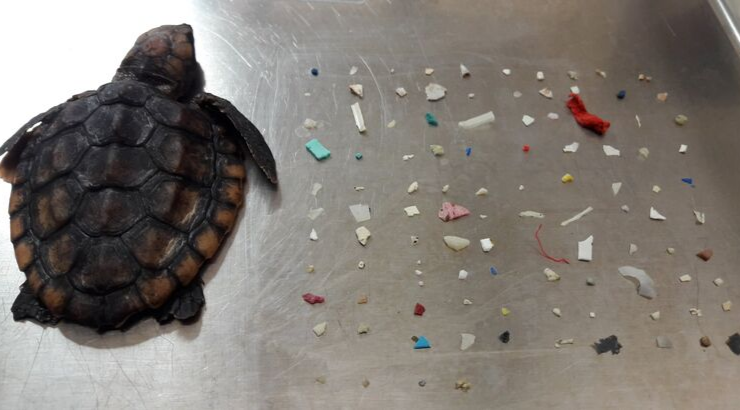Dead Baby Turtle Found With 104 Pieces of Plastic in Its Belly
 By Elias Marat
By Elias Marat
The story is all too common: sea creatures washing ashore, emaciated and starved with their bellies filled with plastic waste.
The latest tragic victim raising awareness of plastic pollution is a baby turtle that washed ashore in Boca Raton, Florida. The tiny loggerhead sea turtle died shortly afterward, and conservationists subsequently found that it had 104 pieces of plastic in its belly.
The tiny turtle’s sad fate was shared by the Gumbo Limbo Nature Center of Boca Raton, who posted a photo on its Facebook page earlier this week showing the dead turtle alongside the pieces of plastic extracted from its intestinal tract.
Widget not in any sidebars
Various types of plastic were lined up next to the turtle, including bottle labels, balloons, and other scraps of plastic debris.
The conservation center said that this time of year is known as “washback season,” a time when turtle hatchlings who successfully made it out to the floating seaweed or sargassum mats in the Gulf Stream begin to return along the coastline.
Sea turtle rehabilitation worker Emily Mirowski examined the turtle before it died, and dissected it after it lost its life. She told CNN:
It was weak and emaciated. I could just tell it wasn’t doing well.
It was really heartbreaking … But it’s something we’ve seen for several years and we’re just glad people are finally seeing this image and hopefully it’s raising awareness.”
Unfortunately, the problem is incredibly common. According to the conservationists, 100 percent of washback turtles who end up with plastic in their stomachs don’t survive.
Mirowski said that since this washback season began, dozens of turtles brought to the center’s rehabilitation center have died, with plastic being the main culprit.
The rehabilitation team at Gumbo Limbo is working hard to save other washback turtles whom they hope they can ultimately save, according to local WPTV.
Rehabilitation coordinator Whitney Crowder said:
“It is a slow waiting game and unfortunately, a lot of them don’t make it.”
In recent years, microplastics have come under heavy focus from conservationists and scientists as they make their way into every space possible—from the tallest mountain peaks to the stomachs of various marine organisms.
The National Oceanic and Atmospheric Administration (NOAA) defines microplastics as fragments of plastic that are smaller than 5 mm in length, or roughly the size of a sesame seed. They’re often so small that scientists across the globe can’t even sample or study them, but the danger that the dye- and chemical-ridden pollutant poses can’t be understated.
Plastic pollution in the ocean has reached such monstrous proportions that an estimated 100 million tons of plastic can now be found in the world’s oceans, according to the United Nations. Between 80 and 90 percent of it comes from land-based sources. According to a report prepared for the 2016 World Economic Forum in Davos, Switzerland, by 2050 it is estimated that plastic waste in the ocean will outweigh all fish.
By Elias Marat | Creative Commons | TheMindUnleashed.com
Subscribe for natural health news to your inbox. Follow Natural Blaze on YouTube, Twitter and Faceb



